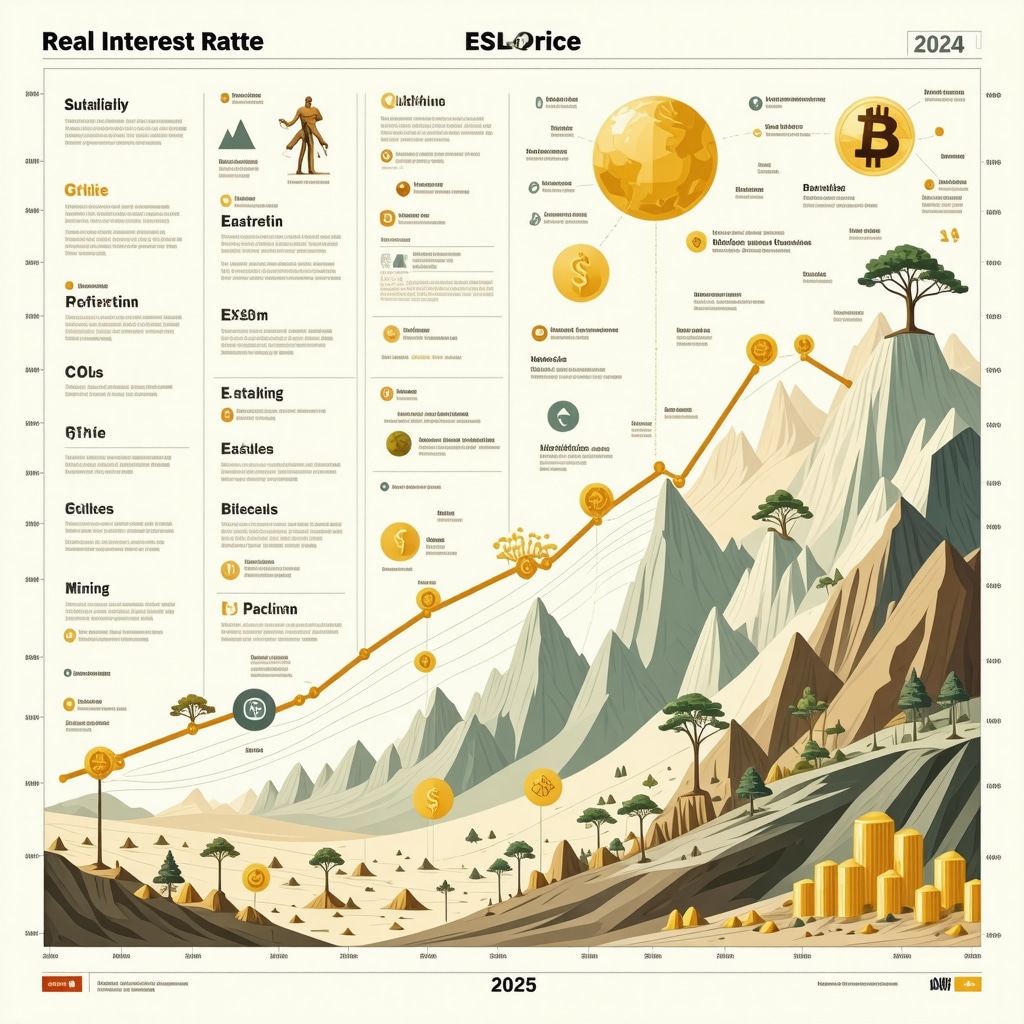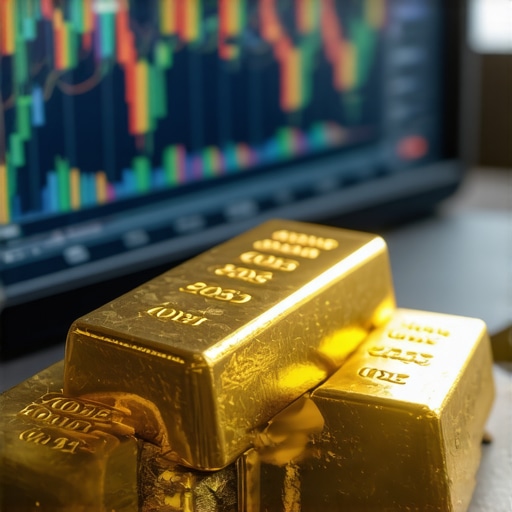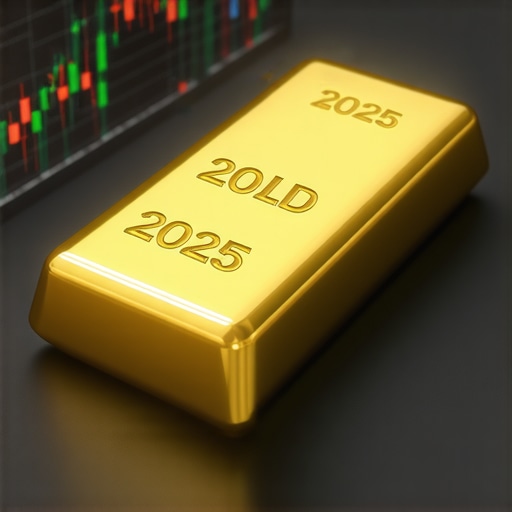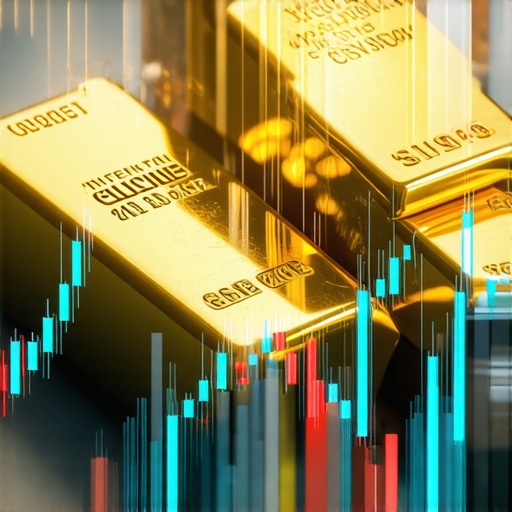Gold’s Glittering Road Ahead: What’s Shaping 2025?
Picture this: It’s early 2025, and the gold market is buzzing louder than a Wall Street trading floor. Investors, from seasoned tycoons to curious newcomers, are all squinting at the same question – where will gold prices really go? The allure of gold has never been merely about shiny trinkets; it’s about security, stability, and a hedge against the unpredictable twists of global economics. But what exactly will drive gold prices in 2025? Let’s embark on a journey through the key drivers and market predictions that could make or break the gold rush.
Unpacking the Treasure Chest: What Are the Key Drivers?
Gold’s price dance is choreographed by a captivating mix of factors. First up, inflation – the sneaky villain that erodes purchasing power. When inflation creeps up, gold often shines brighter as investors seek refuge. Then there’s the interest rate saga. Central banks, with their monetary policy wands, can either dull or intensify gold’s sparkle. Add to the mix geopolitical uncertainties – think trade wars, conflicts, and economic sanctions – and suddenly gold becomes a coveted safe haven.
Don’t forget currency fluctuations! A weaker US dollar typically props up gold prices, making it cheaper for holders of other currencies. Plus, the insatiable demand from emerging markets and central banks’ strategic gold purchases add another layer of complexity to the price puzzle.
Is the Gold Bull Run in 2025 Just a Mirage or the Real Deal?
Here’s the million-dollar question (or rather, the million-ounce question): Will gold continue its golden streak or stumble in 2025? Experts are divided but mostly optimistic. The CNBC report on gold price forecasts highlights that ongoing economic uncertainties and cautious monetary policies could fuel a bullish market. Yet, savvy investors know to watch out for sudden market corrections and shifting global dynamics.
For those looking to dive deeper and build a resilient gold portfolio, exploring strategies like how to build a portfolio with gold ETFs and mutual funds can be a game-changer. It’s not just about buying gold; it’s about crafting a smart strategy that weathers volatility.
What’s your take on gold’s dazzling future? Join the conversation and share your predictions or experiences – after all, the market thrives on diverse insights and lively debates!
Decoding Investor Behavior: What’s Behind Gold’s Persistent Appeal?
Beyond the macroeconomic forces, understanding investor psychology is crucial in anticipating gold’s trajectory. Gold isn’t just a commodity; it embodies centuries of trust as a financial safe haven. Even in the age of digital assets, gold’s tactile, intrinsic value continues to captivate investors. The perception of gold as a hedge against systemic risks—be it inflation, currency devaluation, or geopolitical turmoil—fuels demand, especially when market sentiment turns cautious. This psychological underpinning often amplifies price movements beyond fundamental realities, creating volatility that sharp investors can capitalize on.
How Will Technological Innovations and ESG Trends Reshape Gold Investment in 2025?
As the investment landscape evolves, technology and sustainability are rewriting the rules. Blockchain-enabled gold trading platforms are enhancing transparency and liquidity, allowing investors to trade gold with unprecedented ease and security. Meanwhile, Environmental, Social, and Governance (ESG) criteria are becoming a decisive factor in gold mining and sourcing. Investors increasingly demand ethical practices, pushing mining companies toward sustainable operations and responsible supply chains.
These shifts not only affect market perception but also influence regulatory frameworks and capital flows. For instance, ESG-compliant gold ETFs are attracting a new generation of investors who prioritize sustainability alongside returns. Staying informed about these trends is essential for anyone aiming to harness gold’s full potential in 2025 and beyond.
For an in-depth understanding of how to align your portfolio with these evolving trends, consider exploring strategic portfolio building with gold ETFs and mutual funds. This approach blends traditional wisdom with modern investment vehicles, optimizing for both growth and resilience.
Global Gold Supply Dynamics: Are We Facing a Bottleneck or a Boom?
The supply side of gold is equally pivotal. Mining output, geopolitical risks in key producing countries, and central bank sales or acquisitions can create supply shocks or surpluses. Notably, central banks remain pivotal actors; their strategic gold purchases can tighten supply and propel prices, as detailed in how central bank gold buying influences global demand trends. Conversely, increased recycling and secondary supply can moderate price spikes.
Market watchers should monitor mining sector innovations that may reduce production costs or unlock new reserves, as well as geopolitical developments that might disrupt supply chains. Such factors add layers of complexity but also opportunity for well-informed investors.
According to the World Gold Council’s 2024 report, sustainable mining practices and technological advancements are expected to gradually increase supply reliability while aligning with ESG standards, a balance that could stabilize prices amid demand fluctuations.[1]
Engage with the Gold Community: Share Your Perspectives and Strategies
Gold investing is not a solitary journey but a dynamic dialogue among diverse participants. What innovative strategies are you considering to navigate 2025’s gold market? How do you weigh traditional bullion against digital gold products or ESG-focused funds? Your insights could illuminate paths for others and spark enriching discussions.
Feel free to comment below with your forecasts, questions, or experiences, and share this article with fellow investors seeking to deepen their understanding. For those eager to broaden their expertise, check out our comprehensive guide on gold price forecasts and market analysis for 2025. Together, we can decode gold’s glittering road ahead.

Strategic Gold Hedging: Navigating Inflation Surges and Market Volatility with Precision
As inflationary pressures intensify globally, the strategic use of gold as a hedge demands nuanced understanding beyond the traditional buy-and-hold approach. Investors increasingly employ sophisticated tactics such as dynamically adjusting gold allocations in response to real-time inflation indicators and macroeconomic signals. For example, integrating gold with inflation-protected securities like TIPS (Treasury Inflation-Protected Securities) can optimize portfolio resilience. Moreover, derivatives like gold futures and options offer avenues to hedge against short-term volatility while capitalizing on anticipated price movements.
Crucially, understanding the interplay between nominal interest rates, real interest rates, and gold’s opportunity cost is vital. Real rates—nominal rates adjusted for inflation—serve as a key driver for gold prices; declines tend to enhance gold’s appeal as a non-yielding asset. Thus, monitoring central bank communications and forward guidance becomes indispensable for timing gold investments effectively.
How Do Real Interest Rates Impact Gold Prices Amid Central Bank Policy Shifts?
Central banks’ monetary policy strategies inherently influence real interest rates, thereby affecting gold’s attractiveness. When central banks tighten policy by raising nominal rates to combat inflation, the impact on real rates depends on inflation expectations. If inflation remains elevated, real rates may stay low or negative, sustaining gold demand. Conversely, aggressive rate hikes that outpace inflation can push real rates positive, reducing gold’s relative appeal.
For instance, the Federal Reserve’s nuanced policy shifts over recent years illustrate this dynamic. Market participants closely analyze the Fed’s dot plots, inflation metrics, and employment data to anticipate real rate trajectories. This analysis informs decisions on gold allocation, balancing between safe haven preservation and opportunity cost considerations.
Quantitative Easing’s Legacy: How Past Liquidity Infusions Shape Gold’s Future Trajectory
The legacy of quantitative easing (QE) programs—massive central bank asset purchases during economic downturns—continues to ripple through gold markets. QE increases money supply and can stoke inflation expectations, traditionally bullish for gold. However, tapering of QE and normalization of monetary policy inject complexity into price forecasts.
Investors must consider how residual liquidity, combined with evolving fiscal policies and geopolitical tensions, sustains or dampens gold demand. The interaction between sovereign debt sustainability concerns and gold’s status as a store of value further complicates the outlook. Sophisticated analysis often leverages econometric models incorporating monetary aggregates, inflation forecasts, and fiscal deficits to anticipate gold price inflection points.
Integrating ESG and Technological Innovation: Crafting the Next-Generation Gold Investment Portfolio
Emerging ESG mandates are reshaping gold mining and investment landscapes. Investors seeking both ethical alignment and financial returns increasingly favor companies demonstrating verifiable commitment to environmental stewardship, social responsibility, and transparent governance. This ESG integration is not merely a trend but a structural shift influencing capital allocation and regulatory scrutiny.
Technological advancements such as blockchain are revolutionizing gold provenance tracking, enhancing supply chain transparency, and mitigating risks of conflict minerals. Tokenization of gold assets facilitates fractional ownership and liquidity, opening markets to a broader investor base and fostering innovative investment products.
For portfolio architects, combining ESG-screened gold equities with blockchain-enabled gold ETFs can yield diversified exposure that aligns with modern investor values and regulatory expectations. Continuous monitoring of regulatory developments and sustainability reports is essential to maintain portfolio integrity.
The Intersection of Geopolitics and Gold Supply Chains: Anticipating Risks and Opportunities
Geopolitical tensions in key gold-producing regions introduce supply chain vulnerabilities that can precipitate price volatility. Export restrictions, nationalization risks, and labor disputes in countries like South Africa, Russia, and Peru may disrupt output unpredictably. Strategic stockpiling by central banks amid geopolitical uncertainty can further constrain physical supply.
Advanced investors incorporate geopolitical risk models and scenario analyses to anticipate such disruptions. Multinational mining firms are increasingly adopting risk mitigation strategies including diversified geographic operations and robust stakeholder engagement to ensure operational continuity.
Understanding these dynamics enables investors to capitalize on supply squeezes or to hedge exposure through derivatives and alternative assets.
For those eager to deepen their strategic approach to gold investing, exploring cutting-edge analysis and portfolio optimization techniques can unlock new dimensions of opportunity. Join our expert discussions and access exclusive resources to stay ahead in the complex gold market of 2025 and beyond.
![]()
Mastering Real Interest Rate Dynamics: The Hidden Lever of Gold Valuation
One of the most nuanced yet critical factors shaping gold prices in 2025 is the behavior of real interest rates—nominal interest rates adjusted for inflation. Unlike headline inflation or nominal rates alone, real rates determine gold’s opportunity cost as a non-yielding asset. When real rates fall or turn negative, gold’s allure intensifies, prompting savvy investors to recalibrate their portfolios accordingly. Central banks’ evolving monetary policies, especially in major economies like the U.S. and Eurozone, add complexity to this equation, necessitating agile strategies that anticipate shifts in real yields rather than merely reacting to headline figures.
How Can Investors Leverage Real Interest Rate Forecasts to Optimize Gold Exposure?
Expert traders and portfolio managers increasingly integrate real interest rate forecasts into sophisticated investment models. By monitoring inflation expectations via Treasury Inflation-Protected Securities (TIPS) breakeven rates and central bank forward guidance, investors gain foresight into real rate trajectories. Such analysis can inform tactical increases or decreases in gold holdings, enhancing hedging effectiveness against inflationary surges or deflationary pressures. For those interested in refining their approach, our detailed guide on effective gold investment strategies to hedge against inflation offers actionable insights and risk management techniques.
Quantitative Easing’s Enduring Impact: Liquidity, Inflation, and Gold’s Price Path
While many central banks have tapered or ended their quantitative easing (QE) programs, the residual effects of these unprecedented liquidity injections continue to ripple through gold markets. QE expanded money supply significantly, elevating inflation expectations and boosting gold’s status as a safe haven. However, the transition to monetary normalization introduces volatility and uncertainty, as investors grapple with fluctuating liquidity conditions and evolving fiscal policies. The interplay between persistent sovereign debt concerns and gold’s role as a store of value remains a fertile ground for advanced econometric modeling.[1]
ESG and Blockchain: The Future-Proofing of Gold Investment Portfolios
The gold investment landscape is being reshaped by the twin forces of Environmental, Social, and Governance (ESG) imperatives and blockchain technology. ESG considerations now influence not only investor preferences but also regulatory compliance and corporate disclosures. Mining companies that demonstrate verifiable commitments to sustainability and ethical sourcing enjoy preferential capital access and investor confidence. Concurrently, blockchain-enabled platforms are revolutionizing gold provenance tracking, ensuring transparency and enhancing liquidity through tokenized gold assets. This convergence empowers investors to build portfolios that are both resilient and aligned with contemporary values.
For those ready to embrace this paradigm shift, exploring strategic portfolio building with gold ETFs and mutual funds can provide a balanced approach that integrates traditional asset security with innovative technologies and ESG compliance.
Join the Conversation: Share Your Advanced Gold Investment Insights and Strategies
Gold investing in 2025 demands not only knowledge but also a community of engaged, forward-thinking participants. What advanced techniques or models are you applying to navigate real rate fluctuations, QE legacy effects, or ESG integration? How do you foresee blockchain and tokenization transforming gold’s liquidity and accessibility? Share your perspectives and questions in the comments below to enrich this evolving dialogue. Don’t forget to share this article with fellow investors who seek to master the complexities of the gold market and explore our comprehensive gold price forecast and market analysis for 2025 to deepen your expertise.

Expert Insights & Advanced Considerations
Real Interest Rates as the Subtle Gold Price Catalyst
While headline inflation grabs the spotlight, seasoned investors know that real interest rates—nominal rates minus inflation—are the true lever influencing gold’s appeal. A decline or negative real rates diminish gold’s opportunity cost, making it a more attractive store of value. Monitoring central bank forward guidance and inflation expectations via TIPS breakeven rates enables tactical portfolio adjustments that can seize upside potential or hedge downside risk effectively.
Quantitative Easing’s Lingering Echo in Gold Valuation
Though many central banks have tapered QE, the residual liquidity and expanded monetary base continue to shape inflation expectations and gold demand. This legacy effect, interwoven with sovereign debt concerns, fuels gold’s function as a safe haven. Advanced econometric modeling that incorporates fiscal policy trajectories and global liquidity conditions offers investors a nuanced framework for forecasting gold price inflection points.
ESG and Blockchain: Twin Pillars of Future-Proof Gold Investing
Integrating Environmental, Social, and Governance criteria with blockchain technology is transforming gold investment. ESG mandates pressure mining companies toward sustainable, transparent operations, while blockchain ensures provenance and liquidity through tokenization. This convergence appeals to a new generation of investors who prioritize ethical considerations alongside returns, reshaping market dynamics and regulatory landscapes alike.
Geopolitical Risk Modeling Enhances Supply Chain Forecasting
Supply disruptions due to geopolitical tensions in gold-rich regions remain a potent source of price volatility. Deploying sophisticated geopolitical risk assessments and scenario planning allows investors to anticipate and navigate these uncertainties. Diversification across mining jurisdictions and engagement with multinational firms’ risk mitigation strategies further bolster portfolio resilience.
Dynamic Gold Allocation Strategies Amid Inflation Surges
Rather than static holdings, sophisticated investors adopt dynamic allocation tactics responsive to real-time inflation and macroeconomic signals. Combining gold with inflation-protected securities like TIPS and utilizing derivatives such as futures and options can optimize hedging effectiveness and profit potential amid volatile market conditions.
Curated Expert Resources
World Gold Council’s Supply Trends and Outlook: Offers comprehensive, data-driven forecasts on global gold supply, integrating sustainable mining practices and ESG compliance trends, essential for understanding supply-side dynamics.
https://www.gold.org/goldhub/research/supply-trends-and-outlook
International Monetary Fund Working Paper on QE and Gold Markets: Provides an advanced econometric analysis of how quantitative easing programs impact gold price movements and investor behavior.
https://www.imf.org/en/Publications/WP/Issues/2023/04/15/Quantitative-Easing-and-its-Impact-on-Gold-Markets-520911
Strategic Portfolio Building with Gold ETFs and Mutual Funds: A practical guide on integrating traditional and modern gold investment vehicles, balancing growth, liquidity, and ESG considerations.
https://buyingoldnow.com/how-to-build-a-portfolio-with-gold-etfs-and-mutual-funds
Central Bank Gold Buying Influence Analysis: Deep dives into how strategic acquisitions by central banks affect global gold demand and price trends.
https://buyingoldnow.com/how-central-bank-gold-buying-influences-global-demand-trends
Gold Price Forecast and Market Analysis for 2025: An extensive resource combining macroeconomic, geopolitical, and technological trends shaping gold’s trajectory.
https://buyingoldnow.com/gold-price-forecast-2025-what-investors-should-expect-next
Final Expert Perspective
Discerning the complex interplay of real interest rates, quantitative easing legacies, ESG imperatives, and geopolitical risks is paramount for mastering the gold market in 2025. Gold’s enduring allure as a safeguard against uncertainty remains intact, yet the sophistication of investment approaches must evolve. Embracing advanced analytical tools, dynamic hedging strategies, and ethical investing frameworks will not only safeguard wealth but also seize emerging opportunities in this multifaceted market landscape. To deepen your expertise and participate in this vibrant dialogue, engage with leading resources and share your insights as part of the informed gold investment community.
For those seeking to refine their strategic approach, exploring comprehensive guides on gold price forecasts and market analysis for 2025 and building robust gold portfolios can provide invaluable advantage amid evolving market dynamics.









